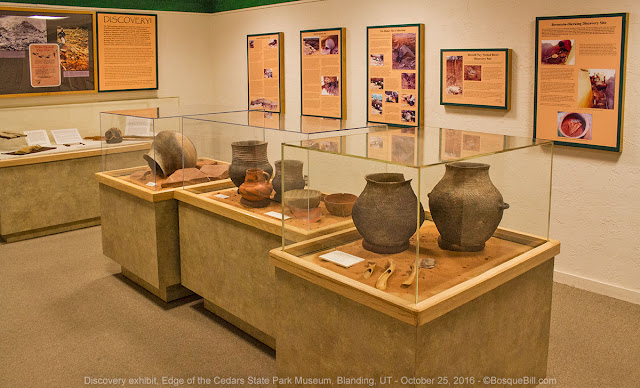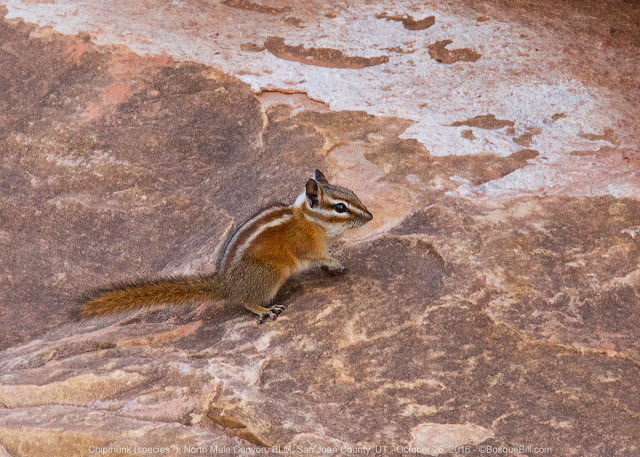October 21 - 27, 2016
I really enjoyed my trip around southern Utah in September and now had an excuse to return to the area. I was to meet friends from the WanderTheWest.com forum for week-end camping, a pot-luck dinner, and hiking. WTW is where lots of folks who own, or are curious to own, pop-up pickup truck campers hang out to share information. The site also features info on travel, parks and camping primarily in the western US. After the meet-up I would spend a few more days exploring on my own.
Not including Angel Peak and Aztec NM in New Mexico, this trip took place within the Cedar Mesa area in Utah. This beautiful natural area with a large number of ancient ruins and native artifacts is primarily administered by the Bureau of Land Management. It, along with other areas adjacent to Canyonlands NP and Glen Canyon NM, it is included in the proposed Bear's Ears National Monument which would be administered by a coalition of native Indian tribes along with the U.S. Park Service. As of this writing the fate of the monument is unknown. It's formation is being fought by the current Utah legislature and some county officials. They seem to favor the state taking control of all Federal lands in Utah to be dispensed as the state sees fit. Based upon recent history, this would likely mean increased oil & gas development, and the opening of sensitive and fragile areas to unrestricted motor vehicle use. I suspect you can guess on which side of the argument I stand. I encourage you to visit the Bear's Ears Coalition website.
[UPDATE 12-28-16: President Obama has just designated the majestic Bears Ears region in Utah as America's newest national monument under the Antiquities Act.
The Bears Ears region — 1.35 million acres of public lands near Utah's Canyonlands National Park — provides drinking water to more than 40 million Americans, boasts spectacular western wildlands and contains an unparalleled concentration of cultural sites, including ancient petroglyphs and burial grounds.
The monument designation will safeguard the Bears Ears from those industrial dangers, honor our nation's Native American heritage and give Native American tribes a greater hand in managing their ancestral homelands.]
Remember to click any photo to see a larger version - highly recommended.
Friday, October 21
I'd seen the BLM signs pointing toward Angel Peak Scenic Area every time I drove US-550 to and from the Four Corners area. I'd wondered what was out there as they seemed to point off toward nothing. My schedule this trip would allow me to find out. As I wouldn't be able to leave town unti Friday afternoon, I could spend the night at Angel Peak which was only a couple of hours drive. Then it would be only a short drive to Aztec National Monument, that I'd never visited, the next morning. I could view the ruins there and still have plenty of time to meet up at Valley of the Gods and prepare for the pot luck.
Angel Peak Scenic Area
I found the BLM webpage for the area and determined there would be camping at Angel Peak Scenic Area, and that it was only six miles off the highway. I turned north off 550 though a new "Landfarm" - what?! That wasn't there a month ago! Acres of land was plowed and furrowed. The soil looked darker than the native sand. A subsequent web search returned this result describing the soil reclamation project.
Not far past the landfarm was a junction, go right for the campground, ahead for an overlook. I'd never noticed in all the times I'd driven by that there were "badlands" just over the horizon. I was aware, and had briefly visited, the Bisti/De-Na-Zeen Wilderness badlands off to the west of the highway. I guess I shouldn't have been surprised to find similar geology here.
There are several picnic areas along the rim before arriving at the campground. This no-fee BLM facility has several campsites, a number of which are located on or near the canyon rim. There are tables, many sheltered by roofs, and vault toilets. I had intended to arrive about an hour before sundown, instead got there about sunset, but was able to get set-up and take a quick look about before dark.
 |
| My campsite |
 |
| The last of the sunset over the badlands. |
Saturday, October 22
I took a walk around the campground area before heading off. I discovered there is a nice trail that follows the rim. There were great views off across the badlands and of Angel Peak.
 |
| Angel Peak |
 |
| Angel Peak Campground area |
 |
| Morning view toward the northwest |
Aztec National Monument
As Bloomfield was only about a half an hour from camp, I stopped at the Blake's there for one of their enormous breakfast burritos. It was large enough to be breakfast and lunch!
The town of Aztec is only a short drive north from there and the national monument is just off the state highway. Here's a link to the Aztec NM website.
 |
| The Great Kiva |
The main archeological site is a large ancestral Pueblo Great House with over 400 rooms.
Archaeological work began in 1916. Under the direction of Earl H. Morris of New York City’s American Museum of Natural History and the visitor center is housed in his original home. The West Ruin also contains the 48 foot in diameter Great Kiva, reconstructed by Morris in 1934.
 |
| Interior of the restored Great Kiva |
 |
| Smaller kiva and the West Ruins |
 |
| Masonry |
 |
| Looking across the West Ruins |
 |
| An interior room |
 |
| Mysterious green stripe of Greywacke sandstone along the western wall. One theory is that is was included to represent the nearby Animas River |
 |
| The back of the visitor center. |
From the monument I took NM-516 toward Farmington. My navigation app directed me west on Piñon Hills Blvd. This bypassed downtown and I was able to see some of the newer, more affluent residential areas of this small city. I turned left on NM-170 and right onto US-64. 64 joins US-160 which I followed to the Mexican Water area where I turned north on US-191. But instead of following the highway into Bluff, I went left on US-163 to the turn off for Valley of the Gods.
Valley of the Gods
 |
| View to the west from our group's camping area. |
 |
| We set up next to this wash where the cottonwood leaves were changing. |
One of the meet-up organizers, "hoyden" (I will use everyone's forum username in this post), lives in Arizona and she had earlier scouted the area and selected the location for our group camp. She chose an excellent site. It was large enough for all, level, easily found, but far enough off the road to avoid dust. Sited on the rim of a wash, the view in every direction was amazing, from the nearby bluffs and formations, to the silhouette of Monument Valley on the horizon.
There were 10 people attending in 7 vehicles, 6 pop-ups and one small travel trailer: "cayuse" and "hoyden" were the organizers, "allenb" & wife, "mikedunn" & wife, "driller" & wife, "searching for nowhere" and me.
We gathered and became acquainted IRL. Meanwhile, I mixed & prepared the ingredients I'd brought from home for this evening's potluck supper. The supper was enjoyed by all and we adjourned to the campfire for stories and companionship. (There were 'No Campfires' signs posted, but Cayuse had called the BLM office in Monticello and they told him the fire restrictions had recently been lifted. He let us know in time for several of us to bring firewood.)
 |
| Wander-the-West folks enjoying the pot luck supper |
 |
| View from the camp at dusk |
Sunday, October 23
 |
| The group camp in the morning light. |
It was a beautiful morning. Those of us who were going to hike to the Moon House ruins, slowly got ourselves organized. mikedunn elected to stay in camp and relax. Cayuse volunteered to lower his pop-top and transport hoyden and myself on the drive to the hike. allenb, the other permit holder, was also going to drive.
 |
| Morning coffee klatch. |
We left Valley of the Gods and drove up the Moki Dugway, about which I've written before (you can click the name in the column to the right of this text for my posts on that subject) to the Kane Gulch ranger station to pick up our hiking permits.
In a slight departure from the format typically used for my blog, this trip is broken into parts not perfectly in chronological order. I am separating the hike to the Moon House Ruins into its own post. Read about the hike and the ruins here.
After the hike to Moon House we drove back to camp, though the west access to Valley of the Gods, hoyden spotted a tarantula crossing the road. We stopped for photos.
 |
| hoyden spotted this guy crossing the road and directed him back off. |
 |
| The view on our way back to camp |
We had a lovely evening in camp with a beautiful sunset, and once again enjoyed hanging out around the campfire.
 |
| Sunset at camp |
 |
| Silhouette of Monument Valley on the horizon. |
Monday, October 24
We said our "nice to have met you in person" farewells as all us Wander the West folks broke camp to go our separate ways. Some were continuing their journeys, others returning home . I was planning to explore up Comb Wash then the northern parts of Cedar Mesa.
The rest of my journey is continued in Part 2.













































